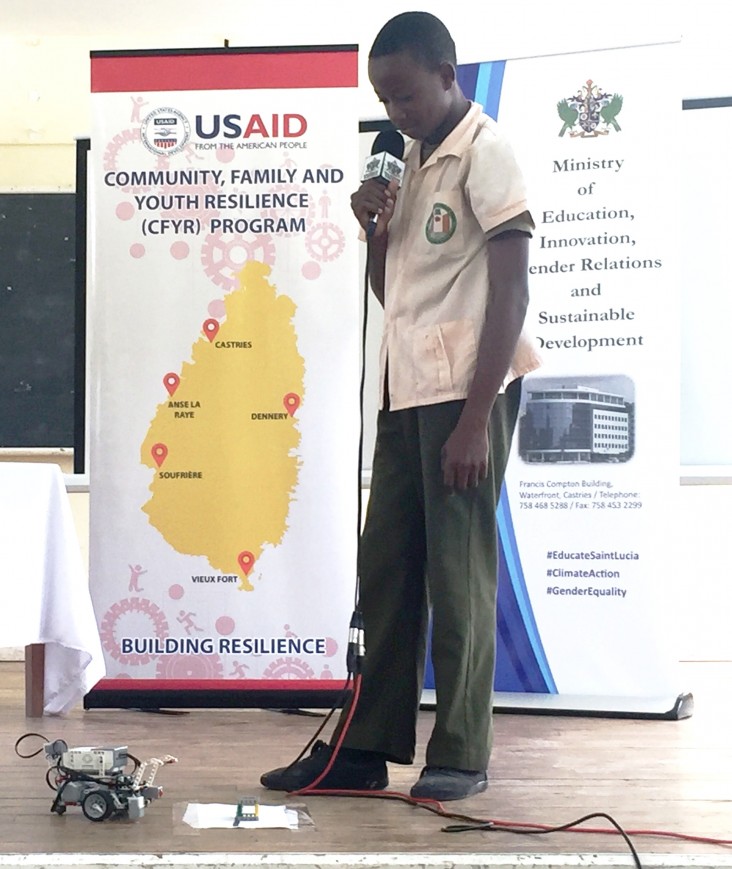Speeches Shim

May 2018 — DENNERY, St. Lucia — Nehemiah Eristhee, 13, is a picture of concentration as he controls his small Lego robot. He smiles victoriously as it successfully navigates its way out of a barricade structure before lifting a small object placed in its path.
“This is exhilarating,” he says. “I don’t want to leave school. Anywhere the robots are, I want to be there!”
Nehemiah is taking part in a USAID-sponsored Robotics and Coding program in his native St. Lucia. The eighth grader is quick to point out that, before starting the program, he had no real interest in pursuing science and mathematics — but that has all changed.
“I am now excited to study subjects like mathematics to learn more about programming,” he says. “I am looking forward to working on it every day.”
He adds that, in addition to increasing his knowledge, the program has also impacted his teamwork skills. “It increases my level of cooperation to work with team members. Before the robotics program, I wasn’t good at cooperating, but now I am better at it!”
Nehemiah is among 240 high school students in St. Lucia benefiting from the Robotics and Coding Program implemented by USAID’s Community, Family and Youth Resilience program in collaboration with the Ministry of Education. The program, which is being piloted in four secondary schools, is planned for eventual integration into St. Lucia’s secondary school curriculum.
In the launch event for the program, U.S. Ambassador to Barbados and the Eastern Caribbean Linda Taglialatela applauded the Ministry of Education’s efforts to inspire a new generation of young people, and underscored the U.S. Government’s commitment to the promotion of science, technology, engineering and mathematics (STEM) education.
“Today, I am hopeful. As I look around this room, I see leaders and future innovators,” said Taglialatela. “I am pleased that the robotics and coding equipment being handed over this morning is part of a larger effort to incorporate coding into the school curriculum — into math, physics and computer science classes. Research suggests that this helps children to work effectively in teams and to solve real-life problems by applying creativity and critical thinking. This is exactly what is needed in our workplaces, communities, homes and schools.”
To date, 12 teachers and four student volunteers have been trained to help introduce the program. Using Lego Mindstorms, an international robotics platform, the 12-13-year-old students are building, customizing and programming their own robots. They then compete and showcase their creativity in a USAID-sponsored, two-day “hackathon.”
Nehemiah and his peers are ecstatic about all the possibilities the program offers. “They all feel the same way I am feeling right now — exhilarated!” he exclaims with a broad smile. He’s already thinking about what he wants to do when he grows up: “Maybe in the future I would like to work for USAID so that I can continue to be involved in programs like the robotics program.”
According to the U.N. Office on Drugs and Crime, five countries in the Eastern and Southern Caribbean report the highest homicide rates in the world. High unemployment and continued challenges with literacy and numeracy put Caribbean youth at elevated risk of involvement in crime and violence.
The Community, Family & Youth Resilience program, which runs from 2016 to 2020, is USAID’s preeminent response to the unprecedented levels of youth violence across the Eastern and Southern Caribbean. The program works in high-risk communities in Guyana, St. Lucia and St. Kitts and Nevis with a menu of prevention programs to build social, leadership and workforce readiness skills. Thirteen after-school programs are currently in progress across the three countries, reaching more than 570 children. Through a range of community activities, more than 2,100 youth have been engaged, 140 community leaders trained in social crime prevention, and more than 160 people trained to support vulnerable youth.
The program targets five communities in St. Lucia, partnering with families, communities, service providers, and government agencies to offer positive opportunities for at-risk youth between 10 and 29 years old. In addition to providing family counseling, the program connects youth with good role models, links them with the private sector to create employment opportunities, and delivers recreational and cultural activities that build community resilience.
LINKS
Follow @usaidescarib, on Facebook

Comment
Make a general inquiry or suggest an improvement.